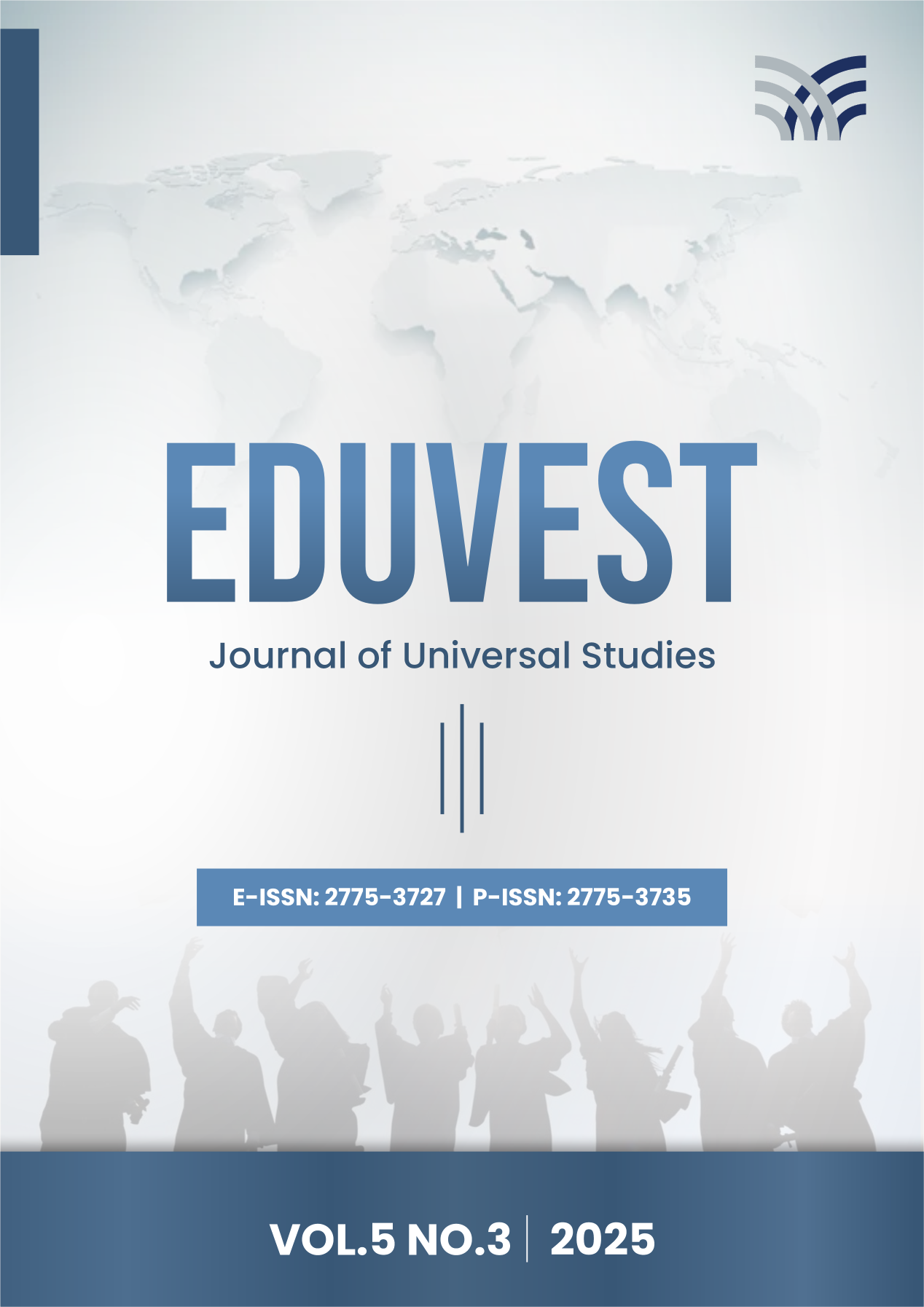Overview of Antibiotic Prescribing Based on Aware Category at Fatmawati Hospital in the Period of May 2024 - November 2024
DOI:
https://doi.org/10.59188/eduvest.v5i3.50291Keywords:
antibiotic, hospital, overviewAbstract
WHO issued AWaRe guidelines to optimize the use of antibiotics to prevent resistance. This guideline is also used in Indonesia, including hospitals. Fatmawati is one of the government hospitals in DKI Jakarta that has the most patient visits. To describe the prescribing of antibiotics in hospitals. Fatmawati based on the AwaRe category. The design of this study uses a qualitative description with a total sampling method and then analyzed using Microsoft Excel. The most prescribing of antibiotics at Fatmawati Hospital as many as 86,833 were in the watch (61.5%), access (30.7%) and last reserve (7.8%) categories. The most prescribed antibiotics in the access group are metronidazole (25.655%), ampicillin (20.835%), gentamicin (12.273%) with the most prescribed dosage forms being tablets (35.064%), sterile powder (30.123%), infusion (22.154%). In the watch group, the most prescribed are ceftriaxone (26.887%), cefixime (22.363%), levoflosacin (17.492%) with the most prescribed dosage forms being sterile powder (47.992%), capsules (21.463%), infusions (14.232%). In the reserve group, the most prescribed are meropenem (62.405%), cefepime (8.705%), ampiscillin/sulbactam (7.919%) with the most prescribed dosage forms being sterile powder (90.93%), tablets (5.695%), and infusions (4.197%). The results showed that the most antibiotic prescriptions were in the watch group compared to the access category. These findings show that it is necessary to re-evaluate PPAB at the hospital. Fatmawati
References
Abdelsalam Elshenawy, R., Umaru, N., & Aslanpour, Z. (2023). WHO AWaRe classification for antibiotic stewardship: tackling antimicrobial resistance–a descriptive study from an English NHS Foundation Trust prior to and during the COVID-19 pandemic. Frontiers in Microbiology, 14, 1298858.
Allel, K., Day, L., Hamilton, A., Lin, L., Furuya-Kanamori, L., Moore, C. E., Van Boeckel, T., Laxminarayan, R., & Yakob, L. (2023). Global antimicrobial-resistance drivers: an ecological country-level study at the human–animal interface. The Lancet Planetary Health, 7(4), e291–e303.
Chukwu, E. E., Oladele, D. A., Enwuru, C. A., Gogwan, P. L., Abuh, D., Audu, R. A., & Ogunsola, F. T. (2021). Antimicrobial resistance awareness and antibiotic prescribing behavior among healthcare workers in Nigeria: a national survey. BMC Infectious Diseases, 21, 1–12.
Gaba, D. M., Fish, K. J., Howard, S. K., & Burden, A. (2014). Crisis Management in Anesthesiology E-Book: Crisis Management in Anesthesiology E-Book. Elsevier Health Sciences.
Hsia, Y., Lee, B. R., Versporten, A., Yang, Y., Bielicki, J., Jackson, C., Newland, J., Goossens, H., Magrini, N., & Sharland, M. (2019). Use of the WHO Access, Watch, and Reserve classification to define patterns of hospital antibiotic use (AWaRe): an analysis of paediatric survey data from 56 countries. The Lancet Global Health, 7(7), e861–e871.
Indonesia, K. K. (2022). Retrieved from kemenkeu. go. id: https://www. kemenkeu. go. id/informasi-publik/publikasi/berita-utama. Perekonomian-Indonesia-Stabil,-Modal-Bagus-2023.
Lekok, W., Natadidjaja, R. I., & Dharmayanti, A. (2021). Regulasi Antimikroba Sistem Prospektif (Raspro): Sistem Tata Guna Antibiotik Untuk Kendali Mutu dan Kendali Biaya di Rumah Sakit Sebagai Upaya Menurunkan Beban BPJS Kesehatan. Media Bisnis, 12(1), 83–88.
Limato, R., Nelwan, E. J., Mudia, M., De Brabander, J., Guterres, H., Enty, E., Mauleti, I. Y., Mayasari, M., Firmansyah, I., & Hizrani, M. (2021). A multicentre point prevalence survey of patterns and quality of antibiotic prescribing in Indonesian hospitals. JAC-Antimicrobial Resistance, 3(2), dlab047.
Mugada, V., Mahato, V., Andhavaram, D., & Vajhala, S. M. (2021). Evaluation of prescribing patterns of antibiotics using selected indicators for antimicrobial use in hospitals and the access, watch, reserve (AWaRe) classification by the World Health Organization. Turkish Journal of Pharmaceutical Sciences, 18(3), 282.
Pauwels, I., Versporten, A., Drapier, N., Vlieghe, E., & Goossens, H. (2021). Hospital antibiotic prescribing patterns in adult patients according to the WHO Access, Watch and Reserve classification (AWaRe): Results from a worldwide point prevalence survey in 69 countries. Journal of Antimicrobial Chemotherapy, 76(6), 1614–1624.
Pauwels, I., Versporten, A., Vermeulen, H., Vlieghe, E., & Goossens, H. (2021). Assessing the impact of the Global Point Prevalence Survey of Antimicrobial Consumption and Resistance (Global-PPS) on hospital antimicrobial stewardship programmes: results of a worldwide survey. Antimicrobial Resistance & Infection Control, 10, 1–12.
Rahmadi, A., Susilowati, S. I., & Pahriyani, A. (2024). Profil Sebaran Antibiotik Berdasarkan Klasifikasi AWaRe dan Potensi Risiko Resistensi di Indonesia. Indonesian Journal of Pharmaceutical Education, 4(2).
Van den Bosch, C. M. A., Hulscher, M., Natsch, S., Wille, J., Prins, J. M., & Geerlings, S. E. (2016). Applicability of generic quality indicators for appropriate antibiotic use in daily hospital practice: a cross-sectional point-prevalence multicenter study. Clinical Microbiology and Infection, 22(10), 888-e1.
Vikesland, P., Garner, E., Gupta, S., Kang, S., Maile-Moskowitz, A., & Zhu, N. I. (2019). Differential drivers of antimicrobial resistance across the world. Accounts of Chemical Research, 52(4), 916–924.
Zhang, C., Li, S., Ji, J., Shen, P., Ying, C., Li, L., & Xiao, Y. (2018). The professional status of infectious disease physicians in China: a nationwide cross-sectional survey. Clinical Microbiology and Infection, 24(1), 82-e5.
Published
How to Cite
Issue
Section
License
Copyright (c) 2025 Panggabean Sylvia N, Retnosari, Subhan, Debby Latuperissa

This work is licensed under a Creative Commons Attribution-ShareAlike 4.0 International License.











